Buqa Fitness - Easyfit Ski-Fit program

The buqa philosophy includes Quality as one of its core components and this goes for their recommended ski-fit program too. Easyfit Personal Training Ltd is one of the top health, fitness and sports training companies in the country with up to date knowledge of how to get the best out of their clients and athletes. Follow their advice here to really improve your ski performance, reduce injury and get the best from your buqa experience.
There is a serious lack of good information available on the web and even in skiing publications about the best way to get fit for skiing. Plus, some of the supposed ski fitness pages were outdated, counterproductive and downright awful! Not only did some of these sites recommend exercises and machines that may actually INCREASE your chances of injury, but they were also using exercises that don't even effectively carry over to skiing.
Examples of this can be many times with exercises such as machine leg curls, leg extensions, and leg presses as important exercises for skiers. This could be further from the truth. We would say they are actually 3 of the WORST exercises any skier could ever do, which not only don’t carry over to skiing, but could even lead you to injury! But that could be a whole subject in itself.
The main goals we need to focus on when training for skiing are:
- Improved leg and core strength to be able to control the body’s movements more powerfully as you move down the mountain in various positions
- Increased muscular endurance, specifically in the legs and lower back, to improve your ability to ski longer and harder with less rest required throughout the day
- Improved agility and quickness to be able to better handle quick lateral movements such as in moguls skiing
- Reduced risk of injury through proper joint mobility, movement function, appropriate muscular balance and coordination between muscle groups.
The exercises here are highly effective, but also the least complicated to follow,and will create the building blocks if you want to get more advanced at a later date.
Every skier should do these types of routines at least for a portion of their workouts. You can even do these workouts at home if you wish.
These workouts involve the most important key exercises that every skier must do. These are what easyfit call the ‘Ski-Fit 6’
1. endurance jump lunges
2. high volume 1-arm swings
3. endurance bodyweight squat matrix
4. 1arm 1-legged Romanian deadlifts
5. Lateral hops
6. Mountain Climbers
The ski-fit 6 are going to be put into an "endurance style" routine that will prepare endurance assaults that you give your body during a typical ski run. These workouts will actually be slightly more intense than a typical ski run (and that's the point), so it will prepare your body above and beyond what you'll need to endure typical skiing, even if you're a hard-core expert on the slopes.
Here's how the main workout is going to be laid out:
Begin with mobility exercises (see below) and squat and lunge matrix (see below)as your warm up before jumping into the circuit below.
1. Jump lunges – as many reps as possible in 60 seconds
Start with one leg forward in the bottom of a lunge position. Your shin should be nearly vertical. To start the jump lunges, explosively jump up in the air, and while in the air, switch legs so that your opposite leg comes down in the forward position. Now immediately jump back up in the air switching legs in the air again. Continue alternating legs on each jump lunge. This is a big time leg burner and great conditioning for all skiers
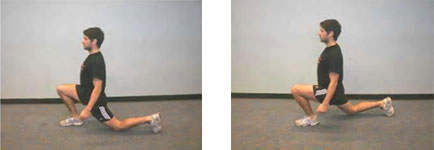
Rest 15 seconds
2. One-arm dumbbell swings – as many reps as possible in 60 seconds
You can do this exercise most simply with a dumbbell. However, you may prefer to use a kettlebell. If you’ve never tried kettlebells, they are a great investment for working out at home. Begin this exercise with the dumbbell slightly off the floor. Start with a slight back swing between your legs to get the momentum going, then swing the weight out and up to a height above eye level. Let the weight fall back down to a position between your legs, decelerate the weight quickly at the bottom, and then use the same hip/leg thrust to power the weight back up into another swing.
It is important to note that you are using your legs and hips to generate the thrust in the swing (your arm is just holding the weight, not doing the lifting). You’re basically coming down into with each swing. High rep swings are great for working the muscular endurance of your legs and lower back – very important for all skiers. High repetition swings are also amazing fat burners that blow any traditional cardio out the window!

Rest 15 seconds
3. Bodyweight Squats – as many reps as possible in 60 seconds
Bodyweight squats are yet another fundamental exercise, but for skiers, we need to focus on high repetition endurance bodyweight squats.
When performing bodyweight squats, you can either start with your arms out straight as shown or with your arms crossed on your shoulders. Stand with feet slightly wider than shoulder width. Keep your eyes fixed straight ahead and back flat to slightly arched.
Then, initiate the squat from your hips by sitting back and down keeping the weight on your heels as opposed to the balls of your feet. Come down to a position where your thighs are approximately parallel to the ground, and then press back up to the starting position following the same movement pattern. Again, you should feel most of the weight on your heels, not the balls of your feet. Also, do not lock out your knees at the top. Contrary to popular belief, properly done squats actually strengthen the knee joint. It is when squats are done improperly that they lead to knee problems.
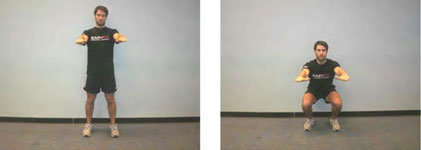
Rest 15 seconds
4. One-legged Romanian deadlifts (with or without dumbbells) – as many reps as possible in 60 seconds alternating legs every 5 reps
This is very important for skiers. Since skiing is such a quad-dominant activity, we really need this exercise to help keep the hamstrings in appropriate strength ratio with the quads. Also, due to the 1-legged nature of this exercise, it involves a great deal of balance and significantly works your stabilizer muscles around the knees and ankles and core helping to keep your joints strong and healthy.
You can do the exercise while holding dumbbells or just with empty hands. Either way is fine. You can progress over time by using heavier dumbbells.
Looking straight ahead, stand and balance on one leg, and kick the other leg out slightly behind you. Maintain a very slight bend in the knee throughout this exercise. Now start to bend forward while simultaneously pushing the bum and hips back and keeping a flat (not rounded) back. While bending over and pushing the hips back, kick your other leg out behind you and reach down with your hands towards the toe of your foot that's planted on the ground and try to touch it. You should feel a stretch in the hamstrings as you get to the deepest part where your back is parallel to the floor. Then, focus on squeezing the bum muscle hard while you reverse the movement and bring yourself back to upright (all the while maintaining that flat back).
Do bunches of 5 reps at a time with each leg for the time duration of this exercise. Focus very strongly on your balance during this exercise. It’s very easy to lose balance if you’re not concentrating.
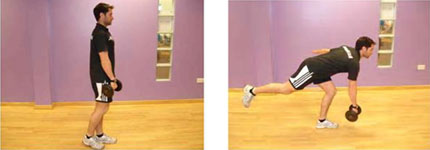
Rest 15 seconds
5. Lateral hops – as many reps as possible in 60 seconds
Lateral hops are great not only for helping to balance out overall leg development, but also for working on your quickness and agility in lateral movements. Done consecutively, and in high repetition fashion, these also are killer leg burners for conditioning the legs. These are a must for inclusion in the ski-fit 6.
You can choose to do lateral hops either across a line on the floor, or onto and off of a step box (hops on floor shown below). If jumping across a line on the floor, you simply start by jumping sideways across the line, and when your feet land, you immediately spring back to the original position and keep this side-to-side jumping motion going for the duration of your timed set. If you’re using a step box instead, you jump laterally onto the step box and then off of the other side, then immediately hop back onto the step box from the opposite direction, and keep going back and forth. You can alternate between workouts whether you use double leg hops og single leg hops – both are great exercises.
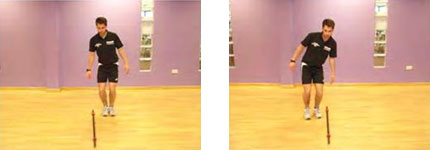
And/or 1 legged

Rest 15 secs
6. Mountain Climbers
Mountain Climbers are a great exercise for the core, legs and cardio endurance and is a great exercise with a few different dimensions to it. The start finish position is a flat press up position(pic1). From there you can quickly jump one leg forward then the other in quick succession so you are constantly alternating the forward leg in an almost horizontal jump fashion (pic 2 ) You can change that version to a ‘legs in and legs out’ version where you quickly jump between feet wide and feet narrow (pic 3). Another option is to rotate the leg through to the opposite side and then quick alternate the other leg to the opposite side (pic 4) and the last option is the good old fashion squat thrust. Jump form the start position tuck both knees under the chest and quickly jumping back out (pic5). Carry these movements out quickly in a explosive sprinting pattern and you soon feel the burn..!

That is 1 cycle. Complete the workout 3 x per week. For the first week, only complete 1 cycle. For weeks 2-3, complete 2 cycles. For weeks 4 and beyond, complete 3-4 cycles per workout. Completing 4 cycles of a workout this intense is really tough, and if you get to this level, your legs are definitely ready to rock down the toughest mountains...
If you don’t have a dumbbell and want to work out at home then you can just do the workout without the 1-arm dumbbell swings and do the 1 legged Romanian deadlifts with no weight , and focus an extra 15 seconds to each of the other 5 exercises, so that you’re doing 1 min 15 seconds for each exercise instead of 1 minute.
So there is you route to hurtling down the mountains without so much as increase in breathing (well, nearly!!).
BUT one of the most important parts of routine must be mobility and flexibility. This should be done before and after workouts and while you are there you need to stay supple for the next days ski and to avoid that leg ache that we all want to avoid the 2nd and 3rd day into our trip.
Introduce these mobility movements everyday you go skiing and everyday you workout (in fact if you spent 10mins every single day of your life doing these it would benefit you in all aspects of your health, not just skiing!)
Hip Mobility – quite simple the key to movement eminates from here. This is the king of mobility and flexibilty exercise
Stand with one foot on a step/chair/bench in a small lunge position with feet facing forward. Gently and smoothly rock the hips forward and back to feel a slight stretch in the hips or top of the thigh. After a few movements start to bring arms above head (straight) as the hip is being rocked into the step.
Then move on to a slight lateral (side) bend away from the foot that is on the floor, keeping the same rocking movement going.
Then move on to a slight rotation away from the foot that is on the floor.
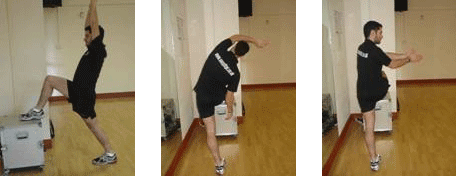
3d Glutes
Hold on to a rail/banister with straight arms. Place 1 foot on to the opposite knee, lean back and bend down into a position where you feel a stretch in the glute. From here slowly move the hips forward & back, side to side and then move the hips round in circles both ways.
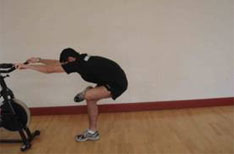
3d Calves
Stand facing a wall with 1 leg in the air and the other in a straight position where a stretch is felt in the calf and the toe is pointing at the wall. From here drive the hips forwards and back for a few seconds then move the leg that is in the air as far to the left and then the right as possible.
Then repeat the same movement with the knee bent.
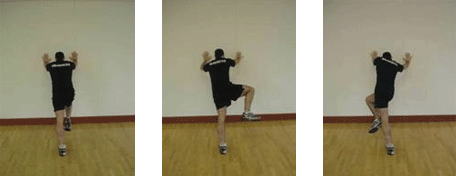
Squat Matrix
This is a 3 stage squat movement aimed at mobilizing all the major joints that influence movement. The first stage is a normal squat but as you come up 1 arm reaches straight up and slightly back to create a stretch. Repeat this movement 4-5times then move smoothly into stage two where the arm reaches over the head to opposite side as you come out of the squat concentrating on hip movement. Repeat that movement 4-5 times before moving into the third stage which is a rotation out of the squat with the arm reaching up and round behind as if hitting a exaggerated backhand in tennis. Repeat with opposite arm.

Lunge Matrix
This is 5 stage lunge movement great for mobilizing and strengthening the legs through different planes of motion. The first is a forward lunge moving straight into a lunge to the side (like a long side step) followed by a rotating lunge (keeping front foot facing forward). Then moving into an opposite side step (looks similar to doing a courtesy!) followed by a cross lunge with foot pointing inwards. Repeat 3-4 time through on both legs.


